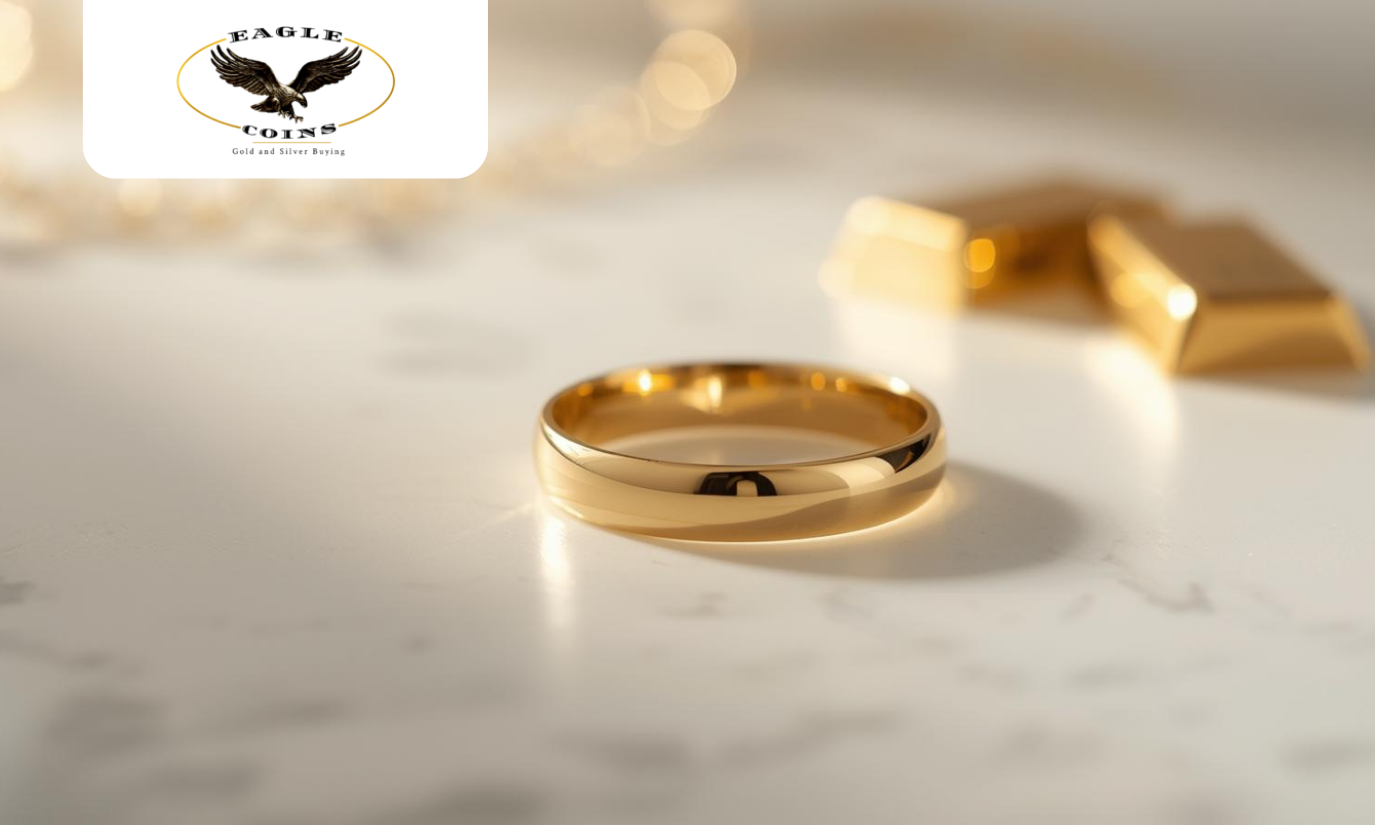White gold, a mixture of the ancient beauty of gold and modern silvery shininess, has been a very fashionable and elegant symbol over the years. White gold is a popular precious metal, either in the form of engagement rings, heirloom jewellery, or coins. However, as the gold market passes through its ups and downs, the question that remains on many people’s minds is, ‘What is the price of white gold per gram in 2025?’
In this detailed guide, let’s explore how white gold is valued, how the market price of this precious metal is influenced, and how you can sell your white gold for its true worth. If you’re looking to sell or learn more about gold valuation, Eagle Coins Gold and Silver Buying can be a reliable centre to conduct correct value estimation and fair market prices.
What Is White Gold?
White gold is an alloy that is formed through a combination of pure yellow gold with white metals such as nickel, palladium, or silver. The result, a bright, silver-white metal that resembles platinum but comes at a comparatively lower cost. The majority of white gold jewellery is also coated with a thin layer of rhodium that enhances its shine and toughness.
The white gold usually exists in different purities:
- 10K White Gold: Contains 41.7% of pure gold
- 14K White Gold: Contains 58.3% pure gold (most commonly used for jewellery)
- 18K White Gold: Contains 75% pure gold (used for luxury pieces)
The higher the karat rate, the more valuable the white gold product.
How Is the Price of White Gold per Gram Calculated?
The price of white gold per gram is determined by three main factors:
- Current Gold Market Rate: Gold prices change on a day-to-day basis depending on the market trends all over the world.
- Gold Purity (Karat): The percentage of actual gold that is in your object that determines the intrinsic value.
- Weight and Condition: The heavier pieces or the pieces that are better in condition yield higher payouts.
To estimate the price of your white gold:
Multiply the current white gold price per gram by the purity percentage of your gold. For example, if gold in the market is at $70 per gram and you have 14K white gold (58.3%), the approximate value of pure gold content would be $40.81 per gram (70 x 0.583).
This is just a base figure; of course, there can be additional value attached to it through jewellery craftsmanship, design, and brand.
2025 Market Overview: White Gold Price Trends
As of 2025, the prices of gold have remained strong due to economic uncertainty and the demand of investors for stable assets. The average price of white gold per gram is closely linked with the spot price of gold, which has seen a consistent increase over the past few years.
On average:
- 10K White Gold: $30-$35 per gram
- 14K White Gold: $40-$45 per gram
- 18K White Gold: $55-$60 per gram
However, these numbers can slightly vary depending on where you sell your items and whether you’re trading in jewellery, scrap metal, or coins.
If you are not sure of the purity of the gold or its weight, specialists at Eagle Coins Gold and Silver Buying may test your piece of gold and provide clear prices based on current market prices.
What Makes White Gold Valuable?
Although white gold is not as pure as the 24K yellow gold, it has the value that comes from the combination of:
- Gold Content: This is the actual percentage of gold in the alloy.
- Rhodium Finish: This is a high-quality coating that makes the product more durable and lustrous, which increases its market appeal.
- Craftsmanship: Complex designs, gemstones, and brand reputation will increase the resale prices.
- Market Demand: White gold remains a popular product in wedding and fine jewellery markets, which ensures strong resale potential.
When selling, it is important to separate the metal value from the design value. The buyers like Eagle Coins Gold and Silver Buying will consider both aspects fairly.
How to Sell White Gold for the Best Price?
Selling your white gold is a simple and enjoyable process if done through a reliable buyer. Here is the way you can get the most out of it:
- Know the Purity of Your Gold: Check for karat stamps (like 10K, 14K, or 18k) on your jewellery.
- Weigh Your Gold: The heavier your item weighs, the more it’s worth.
- Check Current Market Prices: Stay updated on the gold spot rate so that you can make sure that you are selling at a good time.
- Get a Professional Appraisal: Visit a reputable buyer like Eagle Coins Gold and Silver Buying for a correct evaluation.
- Keep the Middlemen out of it: Selling directly to gold buyers can help you save unnecessary cuts to commissions.
White Gold vs. Yellow Gold: Is There a Difference in Value?
Although both types of gold share the same base metal, the value of white gold is almost the same as yellow gold of the same karat and weight. The difference lies mainly in the looks and alloy composition.
However, the jewellery made from white gold might have a slightly higher price if rhodium-plated or crafted by a premium brand. The resale process, however, is mostly focused on gold content, not colour.
How to Check if Your White Gold Is Real?
Not all the jewellery that looks silvery-white is real white gold. Here’s how you can tell:
- Check Hallmarks: A real white gold jewel will have a stamp like 10K, 14K, or 18K.
- Magnet Test: Real gold is non-magnetic
- Professional Testing: The jewellers or gold buyers can either use acid or XRF tests for confirmation.
At Eagle Coins Gold and Silver Buying, you have to chance to receive the true market value as the professional testers ensure that every item is properly checked before making an offer.
Tips Before Selling White Gold
Before selling white gold, it is understood that informal tips help to minimize possible losses.
- Clean your jewellery gently to remove dirt or oils
- Compare offers from various reputable gold buyers.
- The prices of old are subject to change, so keep a watch over trends before selling.
- Retain certifications or receipts, if available, as they can increase the resale value.
The idea behind selling white gold is not simply to sell old jewellery, but to maximize its real worth at the right time.
FAQs
-
How is white gold price calculated?
The price of white gold is decided by its purity (karat), the current market value of gold per gram, and the metal alloys mixed in it, like palladium or nickel.
-
Does white gold go up in value?
Yes, the value of white gold generally increases as time passes as the prices of gold rise in the market.
-
Is white gold a good investment?
White gold can be stated as a good investment, since it holds intrinsic value like yellow gold and retains its resale value.
-
Can I sell my white gold?
Yes, you can sell your white gold in the market to reputable buyers like Eagle Coins Gold and Silver Buying for fair market value.
-
Is it worth selling white gold?
Yes, it is absolutely worth selling gold, especially when the prices of gold are high or if the item is no longer used.
-
What karat of white gold is best?
The most popular options of white gold are the 14K and 18K white gold, which offer a great balance of purity, strength, and shine.
-
Is white gold costly than normal gold?
The white gold can sometimes be slightly expensive than normal gold because of the alloy materials and rhodium plating that give it a bright, silvery finish.
-
Will white gold turn yellow over time?
Yes, white gold can turn yellow over time as the rhodium plating can wear off, but it can also be easily re-plated to restore its shine.


